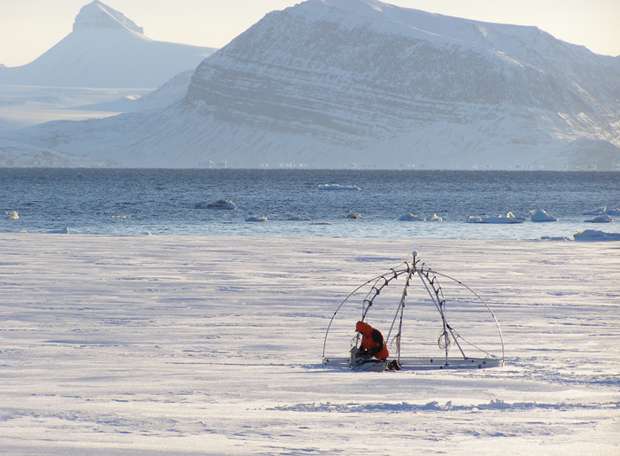Understanding the impact of snow's reflectance

To help improve the accuracy of climate models, an international team involving the National Physical Laboratory (NPL) has measured the reflectance of rough, snow-covered surfaces at large solar zenith angles.
A crucial factor in climate models is Earth's albedo, which is the reflectance of Earth's surface: dark ground has a low albedo, reflecting little light, whereas ice and snow have a high albedo. The Earth's albedo is one of the main factors that determine the amount of sunlight absorbed into the climate system. The balance between the incoming sunlight to that directly reflected or absorbed and reradiated as heat determines the overall warming or cooling of the planet.
Snow-covered surfaces have a high albedo, typically reflecting over 90% of sunlight and cover a large fraction of the planet's surface. Small changes in the albedo, such as a lowered reflectance caused by pollution in the ice, or changes in the area covered, such as sea ice area reduction exposing more dark ocean, can significantly alter the global energy balance. It is therefore necessary to better understand the reflectance of snow, and monitor changes in it, to understand the impact on the climate.
Earth-observing satellites have the ability to monitor remote and inaccessible regions, and with on-board sensors they are able to calculate the albedo of snow. But any singular satellite measurement is at one viewing angle. To accurately determine the overall albedo, the reflectance at all the other angles needs to be modelled. The accuracy of these calculations therefore depends upon the accuracy of the reflectance distribution models used by the satellite.
Ground-based measurements of snow's Hemispherical-Directional Reflectance (HDRF) can be used to improve and validate these reflectance distribution models. HDRF is the reflectance of a surface under direct illumination, such as from the Sun, with no diffuse component (ignoring the incoming light from other parts of the sky), as a function of the viewing angle.
There have been very few studies of HDRF over rough snow (snow with ripples and grooves in the surface), or at very large solar zenith angles (when the Sun is near the horizon) despite this being where satellite data is least reliable and where the snow roughness has the largest effect.
Scientists from NPL, the NERC Field Spectroscopy Facility (NERC FSF), Royal Holloway University of London, and the French-German Arctic research base at Svalbard, have attempted to bridge this gap in data.
During a three-week field campaign in Svalbard the team recorded HDRF data for rough, windblown snow at large solar zenith angles. The measurements were made using the Gonio-Radiometric Absolute Spectrometer System (GRASS), which was developed at NPL. GRASS was specifically designed to take direct measurements of the reflectance of surfaces at multiple angles.
The results revealed that light reflected off the roughest surfaces had the strongest directional dependence. This highlights the influence snow surface roughness can have at large solar zenith angles, and the importance of accurate reflectance models that represent realistic surface types. Full results can be read in the paper published in IEEE Transactions on Geoscience and Remote Sensing.
A complete explanation of the observed effects require studies over larger areas. Further measurements would help satellite calibration and reduce errors in the data used in albedo calculations and thus improve climate models.
More information: Christopher P. Ball et al. Hemispherical-Directional Reflectance (HDRF) of Windblown Snow-Covered Arctic Tundra at Large Solar Zenith Angles, IEEE Transactions on Geoscience and Remote Sensing (2015). DOI: 10.1109/TGRS.2015.2421733
Provided by National Physical Laboratory





















